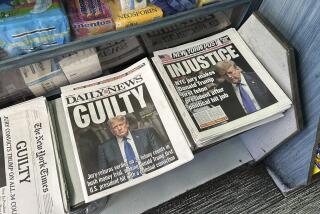Journalism Is a Very Different Business--Here’s Why
- Share via
It’s no coincidence that when journalists refer to The Wall that has traditionally separated the business side from the news and editorial side of a good news organization, they often refer to it as the “church-state wall”--and there is no doubt they see their side as the church . . . or even The Church.
Journalists can be a bit self-aggrandizing, even self-righteous, at times about their mission as truth-tellers--particularly in contrast with what they regard as the bean counters on the business side. Reporters and editors speak of their work as a “mission” and a “sacred trust” and make it sound like some sort of mystic priesthood, with rights and rituals incomprehensible to the nonjournalist. Reporters and editors take particular pleasure in invoking the 1st Amendment guarantee of freedom of the press; their work, they are quick to point out, is the only work singled out for constitutional protection.
Clearly, some journalists have an exaggerated sense of their own importance and uniqueness. But there really is something--several somethings--that distinguish journalism from virtually any other business.
Most businesses survive by giving their customers what they want. A good newspaper gives its customers--its readers--what the editors think they need to make intelligent decisions as citizens and consumers, even if they don’t necessarily want it. To be sure, in their scramble to rebuild declining circulation in an increasingly competitive environment, newspapers have catered to perceived customer desires in recent years, giving readers a plethora of diet, exercise and personal finance columns, lifestyle feature stories and wall-to-wall coverage of Princess Di, Monica Lewinsky and O.J. Simpson. But the better newspapers continue to feel a civic obligation to provide coverage about corporate corruption, government budgets, environmental regulation and legislative machinations, despite readers’ complaints about “too much bad news” and “too many boring stories.”
Acting in Readers’ Interest
As Terence Monmaney, a medical writer for the Los Angeles Times, wrote in a memo to top executives at the paper last month, newspaper stories “serve many millions of people locally and nationally who may not even realize that the information behind improvements in their schools, cops, hospitals and government (among other things) got into the public domain as a result of . . . [a] newspaper’s determined efforts. Few businesses strive to market a product that helps people who do not buy it, yet journalists aim to do just that--by pumping into society the oxygen of news.”
Many newspapers have suffered financially for telling readers what they didn’t want to hear--most notably during the civil rights movement of the 1950s and early ‘60s, when several Southern papers covered (and editorially supported) efforts to win equal rights for blacks. The Lexington Advertiser in the delta country of Mississippi was firebombed by angry readers, boycotted by advertisers and finally forced into bankruptcy. Later in the 1960s, and into the early ‘70s, newspapers throughout the country gave broad, ongoing coverage--and, sometimes, editorial support--to protests by campus activists, antiwar demonstrators, feminists and environmentalists at a time when many, if not most, readers opposed the protesters and the coverage they received.
This behavior runs contrary to both common sense and common business practice, but newspapers realize that if they do not tell the truth, to the best of their ability to determine it, they will not only fail to fulfill their professional obligation, they will ultimately fail as businesses because readers won’t trust them.
“Every newspaper I’ve worked for has done things that were not in their own best interest but were in the best interest of their readers and their communities,” says Dennis Britton, former editor of the Denver Post and Chicago Sun-Times and former deputy managing editor of the Los Angeles Times.
Loyalty to Journalism’s Tenets
Thus, newspapers have often risked government reprisals in order to report news they deemed important to society--most famously in the Pentagon Papers and Watergate cases in the 1970s. In the former, the New York Times and then the Washington Post published a secret history of the Vietnam War in the face of threats by the administration of President Richard Nixon to seek criminal indictments against the papers and their executives. Three years later, the Post vigorously pursued the Watergate break-in story despite fears--later confirmed by transcripts of Nixon’s conversations with top aides--that his administration might retaliate by causing “damnable, damnable problems” when the Post tried to renew the federal licenses required to operate the company’s lucrative television stations.
The Wall itself is a metaphor for another fundamental difference between journalism and other businesses. In a typical business, everyone is expected to work together toward the common goal of improving the company’s financial performance--i.e., making more money; while newspapers certainly must be profitable to survive, making money has traditionally been the sole province of the business side of the paper--the people who sell ads and subscriptions and promote and market the paper. The editorial side--the reporters and editors--feel they owe their primary loyalty not to the bottom line nor even to the company--the newspaper--but to the basic tenets of journalism. As a result, they have not only been free to ignore the issue of profitability but have often done things guaranteed to offend, even damage--and perhaps cost the paper--the advertisers who provide that profitability.
Indeed, this may be the single characteristic that most distinguishes the newspaper business from any other--its willingness (and often its obligation) to bite the hand that feeds it.
Advertisers provide 80% of the revenue for most newspapers, and yet newspapers routinely publish stories critical of or contrary to the best interests of their biggest advertisers or whole groups of advertisers.
As Ray McCutcheon, vice president for display advertising at the Los Angeles Times, puts it: “I have my regular daily routine: I get up, I read the paper and I throw up--because every day, we’re writing something negative about someone I’m going to have to go see that day to sell an ad.”
Negative stories about advertisers don’t appear every day, of course, and there are numerous embarrassing examples of newspapers, especially in smaller towns, bowing to pressure from advertisers. Several newspapers, for example, have caved in to automobile dealers after suffering costly advertising boycotts triggered by stories that disclosed some of the dealers’ shady practices. To the astonishment and dismay of many in the media, a nationwide survey of 105 newspaper editors and 60 publishers published this month in Editor & Publisher magazine showed that 19% of the publishers and 11% of the editors thought it was acceptable for newspapers to consider “killing or holding a story that might negatively portray an advertiser.” About 9% of the survey sample said they had “already killed or altered such a story.”
But more than half those respondents were from newspapers with less than 100,000 circulation. Such acts are the exception, not the rule, in the recent history of the country’s better newspapers, especially the major metropolitan dailies. In the same Editor & Publisher survey, more than 80% of the respondents said a newspaper should never kill, delay or alter a story that might negatively portray an advertiser, and 76% said they had never done so; 86% said reporters should never be asked to include an advertiser in a story. Four out of five editors and almost every one of the publishers said advertisers had pulled their ads to protest unfavorable coverage, and virtually every respectable newspaper has had advertisers do likewise--sometimes for months at a time. The better newspapers, regardless of size, do not soften their coverage to woo back advertising dollars.
“Early this year, we ran a number of stories, one in particular, that was critical of how home builders in the Chicago area . . . stretched the truth in brochures and other material they put out,” says Howard Tyner, editor of the Chicago Tribune. The home builders pulled a “a million dollars’ worth or more” of advertising, according to Dennis Grant, vice president for advertising at the Tribune.
David Scribner, editor of the Berkshire Eagle, a 32,000-circulation newspaper in Pittsfield, Mass., says a local health care network canceled all its advertising for “a whole year” because of the paper’s critical coverage of the network. “They wouldn’t even let patients in their hospital get our paper delivered to their rooms,” he says. But like the Tribune, the Eagle continued its critical coverage.
“Frankly,” Scribner says, “when you have an advertiser pissed off at you, you know you’re doing something right.”
That’s the attitude most good journalists take. But over the past two decades or so--as rumor, gossip, scandal and sensationalism have come to occupy ever more media space and time--news media credibility has plummeted. When Editor & Publisher asked newspaper editors how they would assess “the level of popular trust and confidence in newspapers,” only 11% said “high” or “very high.”
Late last year, in a survey of the public conducted for the American Society of Newspaper Editors, respondents by a 2-1 margin agreed with the statement: “Journalists chase sensational stories because they think it’ll sell papers, not because they think it’s news.” Almost 60% said newspapers are more concerned with making profits than with serving the public interest--and about half the 3,000 respondents said they think newspapers allow advertisers to influence news decisions.
Keeping the Flame of Impartiality
Even without the tabloidization of the mainstream press in recent years, that attitude would not be surprising. “Because we’re funded by advertisers . . . there’s a natural suspicion on the part of readers that’s inherent in the relationship between newspapers and their advertisers,” says Jeffrey S. Klein, a former senior vice president at the Los Angeles Times and now president of 101communications, an Internet magazine publisher based in the San Fernando Valley.
Jack Fuller, president of Tribune Publishing Co. in Chicago, makes a similar argument.
“We’re attempting to persuade the public that we’re doing our best to tell them the truth, regardless of the consequences to us,” he says. “That’s counterintuitive. It’s not easy for people to believe that.”
Because of that, Fuller says, newspapers must “go out of their way to do things that will give people the confidence that we really do behave that way.” Newspapers must also do everything they can to avoid even the appearance of a conflict of interest--or any other kind of impropriety--involving their advertisers or the people and institutions they cover. That’s why journalists at The Times and throughout the country were so outraged when the paper devoted an entire issue of its Sunday magazine to the new Staples Center--and then split the profits from that magazine with Staples Center.
More to Read
Inside the business of entertainment
The Wide Shot brings you news, analysis and insights on everything from streaming wars to production — and what it all means for the future.
You may occasionally receive promotional content from the Los Angeles Times.










